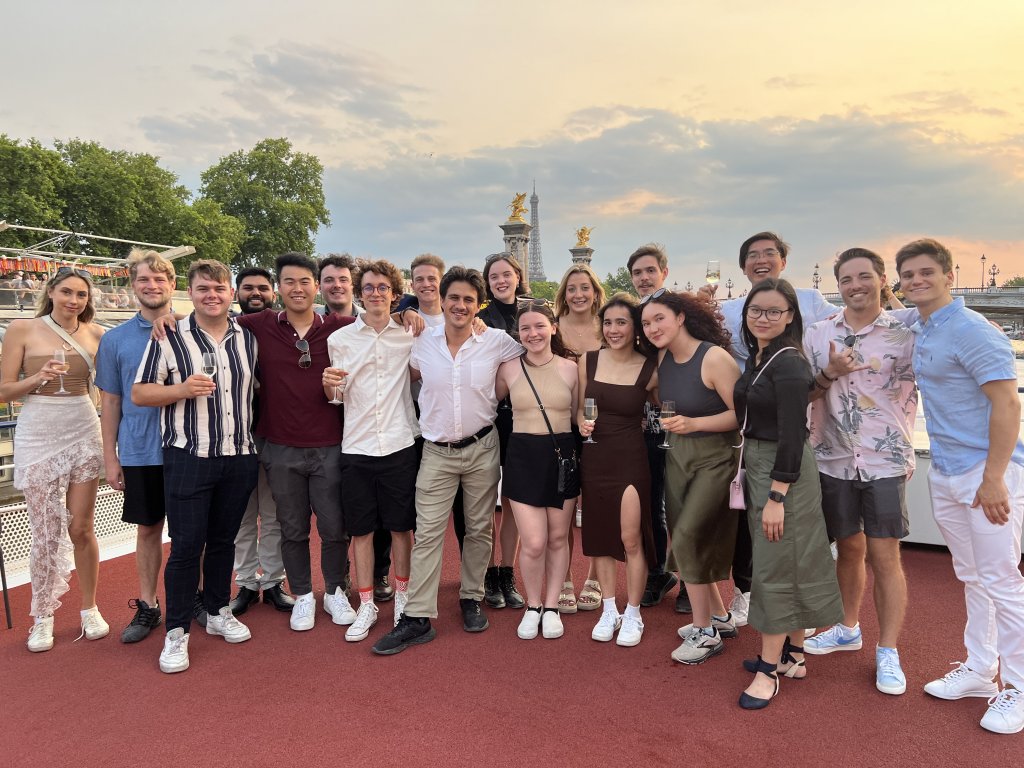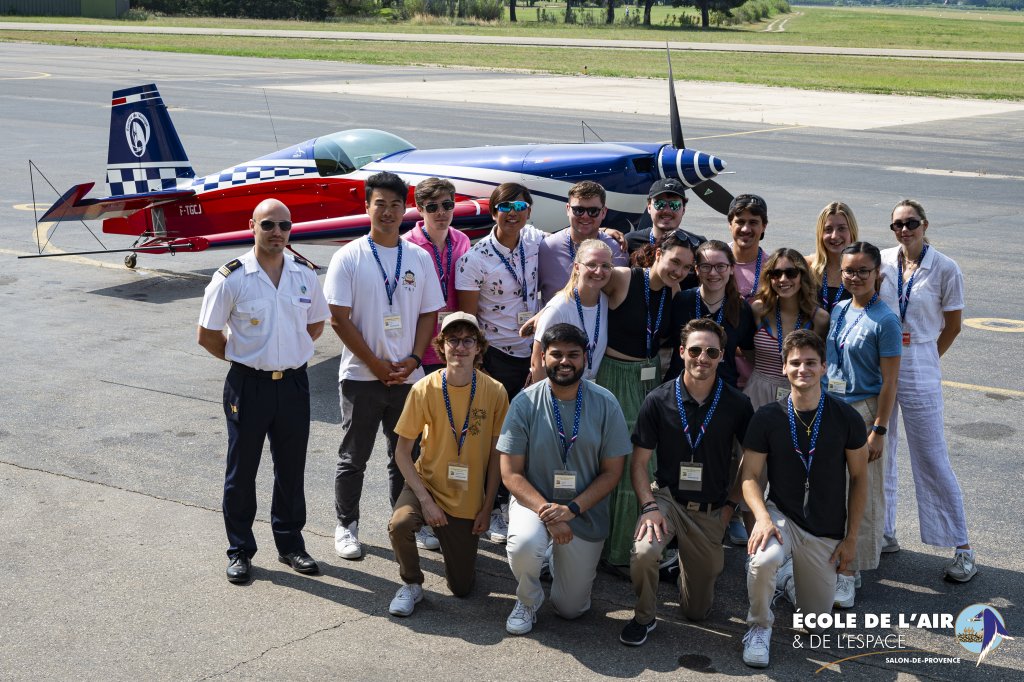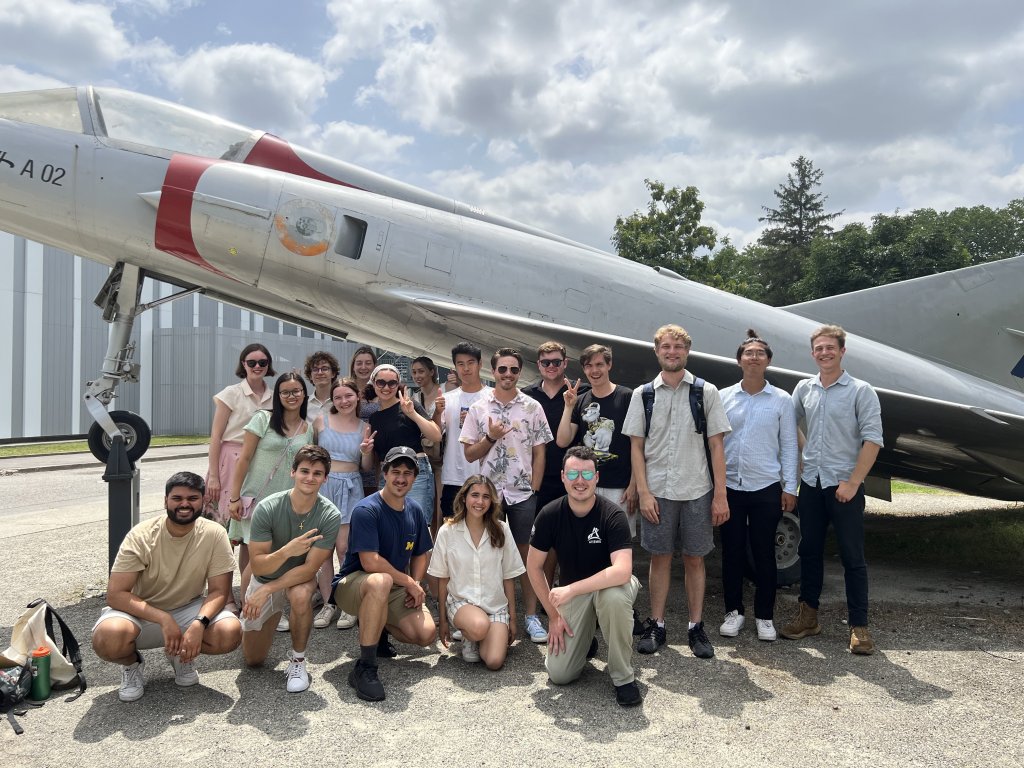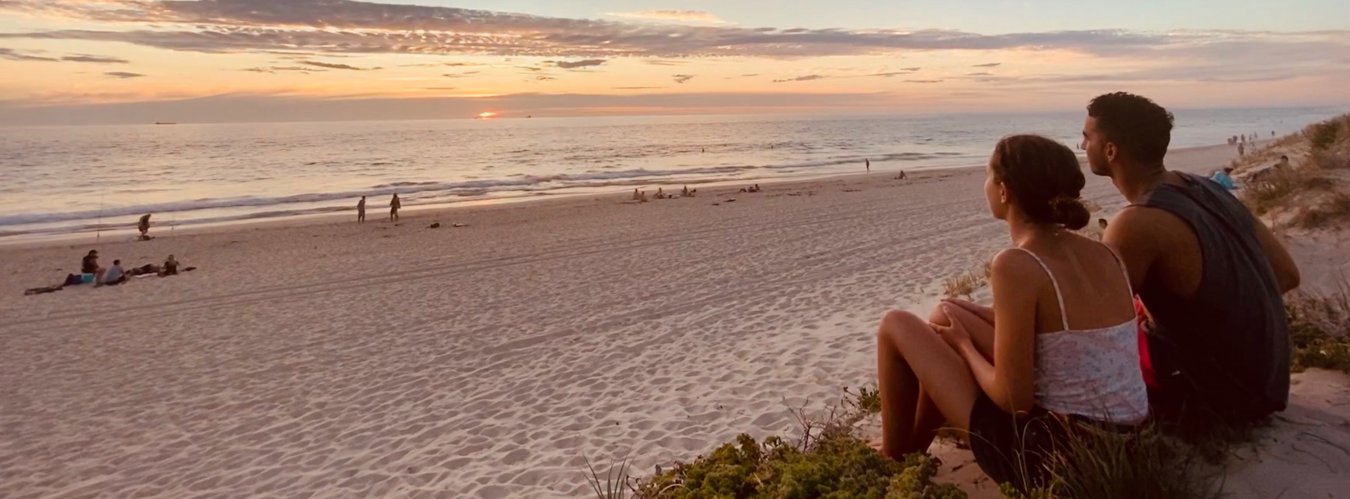I was privileged enough to attend the ISAE Aerospace Summer Program over the course of 5 weeks in France, travelling across 4 cities with 18 other students studying in the USA, Australia and of course at Southampton. This was genuinely the best summer I’ve ever had and I’m sure that everyone else on this trip would say the same; it is an incredibly worthy experience that I would encourage anyone to apply for if you would like to study abroad but perhaps not for as long as a semester.
Our first stop was Poitiers, a small historical city in the west of France only a couple hours away from Paris by train, where the Anglo-Gascons fought against the French Army during the Hundred Years’ War in 1356. We were greeted by our group leader, Kaitlyn, who became our mother goose for the entire program; we are an eclectic bunch of various cultural backgrounds and most conversations at meals were either about our different education systems or the friendly mockery of our different English-speaking accents. This first week was definitely nerve-wracking, as with any first week in a new place of strangers; no one knew what to expect from the course we were about to partake in or if we would all get along. Lucky for us, the school (ISAE-ENSMA) organised a game night not only as an icebreaker for our group, but also as a gathering to meet those currently studying at the university, whom were very welcoming and at least were our local contacts whilst in France. Besides learning a decent amount of survival French on our first day of class, we were given a crash course on radiative heat transfer and thermal management on spacecrafts, and were tasked with modelling a CubeSat for a specific mission using a software called Systema. Though these workshops seemed challenging, it gave us great insight into the decision making for designing a satellite. As we had our weekend free to ourselves, we took the opportunity to visit the beach in La Rochelle about an hour and a half away by train, which marked the first day of summer for most of us who had just finished our exams a week prior. ISAE-ENSMA happened to be a 10-minute walk from Futuroscope, an amusement park filled with futuristic attractions in the field of technology, film and multimedia. Numerous rides had IMAX screens and 4D effects that require you to be securely strapped into your seat, which definitely unleashed our inner child with intrigue of all the science and engineering behind the scenes; that was the best way to end our week in this picturesque town.
Our second stop was Paris, the capital of France, for a total of 10 days. Beyond our busy schedule of lectures, we all had plans to visit a multitude of museums and landmarks, and ultimately try a bunch of amazing cuisines. Most recommendations were from Instagram and TikTok, hence thorough time management was needed over the two weekends that we had free. One of the most memorable experiences was the dinner cruise on the Seine; what a luxury it was to have spent 3 hours enjoying French delicacies and admiring the views of Paris at night. However, it was a slight rollercoaster getting there. The accommodation we were staying at was close to the school (ESTACA), which was almost an hour away by train from the Eiffel Tower, where we were meant to meet at by 8pm. I was personally running a bit late and when I caught up with some of the group walking towards the train station, one of the heels of my sandals had detached. As we didn’t want to miss the train nor be late for the cruise (though the French norm is to be fashionably late), there was no time for me to run back and grab a different pair of shoes, so with a pocketknife, we attempted to remove the other heel and it miraculously broke off with ease. I honestly felt more comfortable walking on the flat insoles; this way I could actually run for the train. We ended up waiting on the train for 10 minutes past the time it was supposed to leave, only to realize that it had been cancelled and the next couple trains were delayed (typical public transport issues). Eventually we had to get Ubers instead, telling the drivers to floor it in hopes to get us there before the boat leaves without us. When we arrived, it turns out that the boat was not boarding anyone yet and was only due to leave at 8:45pm, so that was an unnecessary rush but we wouldn’t have wanted to risk anything for this once-in-a-lifetime excursion. Overall, it was the best evening spent in Paris.

Over the course of 5 days, we had a series of classes on launcher systems from lecturers who have worked or are still working at ArianeGroup, thus we were taught in detail about the Vega and Ariane rockets. Some topics were harder to grasp considering I had just finished 2nd year of my degree and the GNC (guidance, navigation and control) section was aimed for those in a masters program, or at least having done 3rd year. Nevertheless, it was quite interesting and this module of the program was what drew me to apply in the first place. Whilst I wanted to participate in this program this year due to my eagerness to study space-related content, the Paris Air Show at Le Bourget changed my mind and direction of interest. Even though the European Space Agency had replicas of the Ariane 5 by their booth and were holding small conferences where the infamous French astronaut Thomas Pesquet was part of the panel, the performances of numerous aircrafts were the highlights of the day. I was in utter shock watching the flights of the Dassault Rafale, Lockheed Martin’s F-16 Fighting Falcon as well as the F-35 Lightning II (flown by a female pilot!), and many other daredevil aeroplanes; as a fan of Top Gun, this was the absolute dream to witness. I had also never seen a helicopter recover from stall and dive like the H-665 Tigre from Airbus Helicopters (formerly known as a Eurocopter), nor had I seen an Airbus A321XLR fly majestically with the musical accompaniment of Strauss’ Blue Danube Waltz. We had been out in the scorching sun gazing at the sky for over 4 hours and a few of us had tickets to visit the Louvre in the evening before sunset. It was a completely different vibe for us showing up at an art museum full of history, looking rather sunburnt and having spent most of the day with a majority of people wearing aviator sunglasses and caps, instead of wearing floral dresses ready for photos with the prestigious Mona Lisa. Needless to say, I feel accomplished and satisfied to have fulfilled everything on my bucket list in La Ville Lumière.
Our next stop was Salon-de-Provence, a small village in the south of France close to the French Riviera, home to the French Air and Space Force. Since we were to attend classes on the air base, we were instructed to wear trousers even in 30°C weather. I initially thought it would be unbearable considering I already had to buy bottles of water to cool down in Paris, however despite the 10-degree temperature increase, the airconditioned classrooms made a huge difference. It is not common for places to be airconditioned in France, which was why we were given foldable fans at ISAE-ENSMA and had to rely on opening windows at ESTACA. The course on space telecommunications was taught by a commandant (equivalent to a major) who also organised the entire schedule in Salon. Although the material seemed somewhat of a revision of the 2nd year Astronautics module, there certainly were more complex factors to consider when designing downlink communications for a small satellite mission to quantify light pollution over Earth, using the scenario simulation on Systems Tool Kit (STK) software. Another challenge we had to face was the fact that our French teacher for the week decided to conduct all her classes solely in French; with all of us at different levels of French and mostly beginners, you can imagine the pure confusion and frustration on our faces. I was able to retain some knowledge of my IGCSE French and practice a little on Duolingo, so I could just about grasp what the teacher was saying as she slowed down her speaking pace. It did spark reminiscence of my language classes at secondary school when we were tasked with role play conversations when ordering at a restaurant and enacting them in front of the entire class, in which some people took their drama skills to the next level. Thus, our French teacher claimed that we were the most amusing class she had ever taught.
As we only had about 5 days in the area due to important events at the Air Force, we had many excursions crammed into 3 days. The first activity was a wine and olive oil tasting at Chateau Virant, an ancient estate owned by the Cheylan family of winemakers and olive growers. We tried two types of olive oil which had distinct differences depending on when the olives were harvested, as well as their standard white, red, rose and port wines, though I believe the one thing we unanimously agreed was the best was their balsamic vinegar. I would’ve liked to have a wine and cheese pairing, considering France has an enormous variety of cheese, however I understand that it might seem unfair and disrespectful to those who are lactose intolerant and/or vegan. The next morning, we had the opportunity to watch the Patrouille de France rehearse their aerobatic routines in preparation for competitions in the coming weeks. We had previously seen them at the Paris Air Show so this was even more impressive to be up close witnessing a world champion pilot perform insane drills and pulling up to 10 G’s in acceleration. That afternoon, we went to a beach in Marseille owned by the military, and I don’t think many of us were made for this visit, especially me. I had a lovely relaxing time even though I did end up getting first aid care after only making it through part of the nearshore, whereas the majority were ambitious enough to climb a huge rock in the distance. It was maybe one of the rockiest shores I had ever encountered and the rough surfaces had left a few deep cuts on our feet; my wounds in particular did not stop bleeding for a long while so I needed a large supply of plasters (I think it’s pretty clear that I am not made for the water and the lifeguards would undoubtedly agree). On the final day of class, we watched a couple Dassault Mirage jets soar across the air base and a spectacular performance from the Patrouille de France, which undeniably intensified my urge to learn to fly an aircraft. Whilst this was an incredibly short stay, Salon was surely the most memorable, mainly for all the hours we spent together bonding as a group in this little town.

The final stop of the program was Toulouse, the fourth-largest city in France, where we arrived a couple days after the height of the riots following the fatal shooting of Nahel Merzouk. We were extremely fortunate to have avoided the riots in Paris and Marseille as they happened right after we had left; we even escaped a magnitude 5.8 earthquake in Poitiers. Within the first few minutes of stepping foot onto the streets of Toulouse, many of us immediately thought we’d live here in the future. Besides the medieval architecture and contemporary art, there is something so special about the serenity of a modern bustling city and nothing beats the sincere hospitality in the south of France. It was evident from the first night that your age doesn’t determine the amount of fun you can have, as there were tango classes held in plazas with the elderly being the majority of the participants, embracing their youthfulness on a summer evening.
The course for the last 10 days of the trip was on project management with regards to the space industry as a new wave of missions are introduced alongside Ariane 5’s final launch. Every lecturer had an outstanding amount of experience working in sectors all across the world, which as you can imagine led to a number of interesting stories being told, and probably the most inspiring to conclude this program. At every school that we’ve been to during these 5 weeks, each institution had promoted and briefed us on their graduate programs and research opportunities. I believe after just one day of being on campus at ISAE-SUPAERO, most of us agreed to apply to their graduate program after finishing our respective degrees. There was somewhat a sense of belonging as we’d spend our lunch break in the library after enjoying perhaps the best cafeteria food, refreshing our minds with jigsaw puzzles and jenga towers before indulging in the fun activities for the rest of the day. We had scheduled visits for the majority of the afternoons such as guided tours at Aeroscopia and Cité de L’Espace — the two spectrums of an Aeronautics and Astronautics degree. There was an impressive collection of aircraft at Aeroscopia, including an experimental Concorde and a Super Guppy — the predecessor of the Airbus Beluga, and we were also able to walk through the Airbus A300B and A380 to observe the cockpit, the instrumentation onboard, the structures beneath the carpet floor and the evolution of cabin classes. Having learnt about the Ariane 5 rocket for the past month, the tour of the Cité de L’Espace was truly a test of our knowledge on its features and the history of space exploration. One of the excursions I found surprising was the Halle de La Machine, a museum exhibit of funky inventions by the Compagnie La Machine that came to life with the help of trainers/manipulators. Some machines produced music by adjusting gas valves to flicker flames at different rates through a number of pipes, or a mechanical wheel of guitars that would be strummed every revolution; other machines were designed taking inspiration from flora and fauna such as cedar trees and polar bears. The main attraction, however, was Le Minotaure — a 45-feet-tall wooden and steel puppet that serves as a ride to hold up to 50 people onboard. This creature was driven on wheels with “machinists” controlling its leg movements, even its tail, as well as the head movements such as the batting of its eyelashes and the mist emitted from its nostrils, where it occasionally sneezed and produced a shower of “snot”. Our final visit was at Airbus Defence and Space, where we had the chance to observe engineers in the cleanroom in action, whilst we were attentively supervised behind a glass window and prohibited to take any photos.
On our final day in Toulouse, we had a “cultural rally” arranged in the city centre which was an event similar to the Amazing Race, where we were split into groups to take photos of specific places according to the tasks listed for us. Although this wasn’t meant to be an actual race, we definitely treated it like a competition, despite not receiving any reward afterwards. It was truly just to kill time and delay packing our bags for departure the next day. We also had a short graduation ceremony from the course, clearly a huge relief that we all passed, and spent our last evening together in La Ville Rose with a “family dinner” and a board game night at the bar by our hotel. It was a bittersweet moment, not to mention the emotional following 24 hours as goodbyes were said and long hugs were shared. I believe it had to end this way for the best; 5 weeks of travelling was sufficient enough to not drive us insane, though our mother goose might disagree on the amount of chaos we caused.

This was an immensely unforgettable experience and I always regret not getting to know people earlier, wishing I opened up to being more of a social butterfly sooner. It was the trip of a lifetime and was definitely way beyond my expectations; I never would’ve thought that I’d make so many friends for life and we promised that we better see each other again soon. I am truly grateful to have had this opportunity and for anyone interested in embarking on a summer program abroad, I’d recommend to just let loose, cherish every special moment with people you meet and seize any chance you’ve got to explore as many places as you can.
